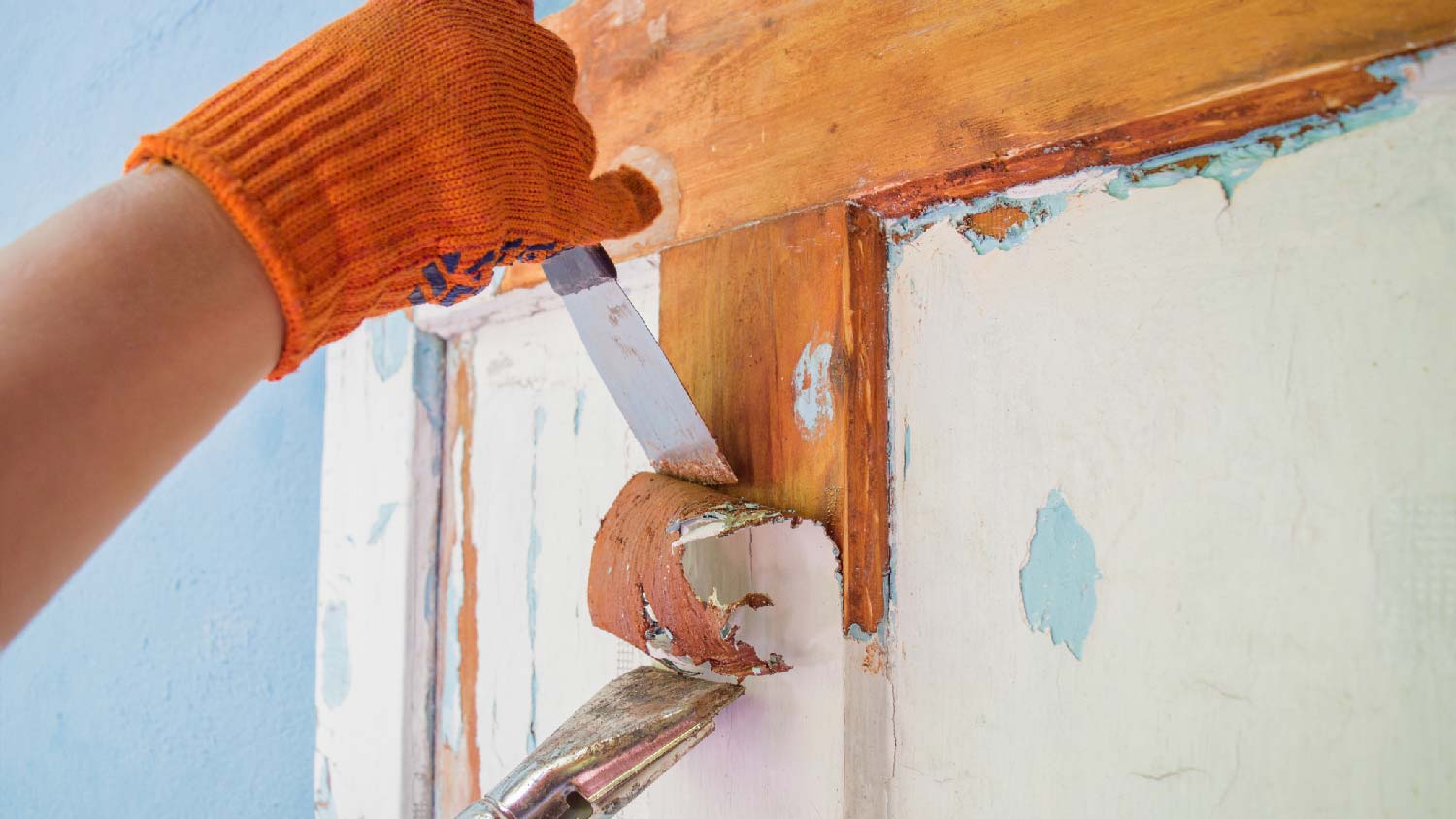
The cost to paint the interior of a house in Dallas, TX depends on size, layout, type of surface, and more. Learn what factors can influence your total in this guide.
Interior painting costs depend on your project and location. Check with a local pro for your specific job.
A paint removal project costs $600 on average but can range anywhere from $150 to $80,000 depending on the scope.
Paint removal costs between $9 and $12 per square foot, so the size of your project has a big impact.
Removing paint from kitchen cabinets, for example, costs $600 to $4,000, while removing paint from a door costs $150 to $300.
Surface prep for a new finish can add between $1 and $5 per square foot to the project cost, and professional repainting can cost hundreds or thousands.
Paint removal costs $600 on average, but there are many factors at play that can leave your total as low as $150 or as high as $80,000. Understanding what affects pricing can help you budget more accurately and find a good deal on professional paint removal services.
In this guide, we’ll explain what affects paint removal costs to help you get a better idea of your total.
Paint removal costs can range widely, with prices falling anywhere between $150 and $80,000. The following factors will have the biggest impact on your total.
The most important factor to consider is the square footage of the material from which you need paint removed. You can expect to spend between $9 and $12 per square foot, so the size of the project will have a significant impact on your total.
Some smaller paint removal projects, like stripping paint from stair banisters, will often be the most affordable. The most extensive and costly projects will be removing paint from wood siding, and mid-range projects like stripping paint from stair steps or windows will have prices that fall somewhere in the middle.
| Project | Paint Removal Cost |
|---|---|
| Kitchen cabinets | $600-$4,000 |
| Door | $150-$300 |
| Door/window trim | $150-$200 |
| Fencing | $1,500-$3,600 |
| Handrail/banister | $150-$600 |
| Stair runners/risers | $900-$1,200 |
| Wood siding | $10,000-$80,000 |
| Wood window | $150-$500 |

Removing paint from wood averages between $9 and $12 per square foot, while removing paint from metal like a wrought iron fence sits between $2 and $8 per square foot. Wood is porous and more susceptible to damage and discoloration from paint strippers and scraping, and it also holds onto paint more readily, so it requires more labor to remove the paint. Paint sits on top of metal, which is more durable, so removing paint takes less labor.
Removing paint from brick will cost between $4 and $8 per square foot, but prices can rise to around $17 per square foot if the paint tests positive for lead.
If you need other services to rectify painting accidents, like removing paint from tile or vinyl flooring, your total will often include a flat fee of between $150 and $250. However, that can increase depending on how much paint you need to remove.
There are a few ways a professional can remove paint, and the one that works best depends on the material and how smooth the surface is. Your expert can help you determine the best option for your project.
| Removal Method | Cost (per Sq. Ft.) |
|---|---|
| Paint scraper | $2–$9 |
| Paint stripping chemicals | $2–$10 |
| Sanding | $4–$12 |
| Heat/steam | $6–$12 |
Nearly 100% of your total cost will go toward labor, as the materials to remove paint are affordable and often reusable. Anything that makes the work take longer will drive up your prices.
For example, removing paint from a wood window may require removing the sashes to access the surfaces more easily, which will increase labor costs. Similarly, removing paint from wood shingles will become more expensive if you have multiple floors that require using ladders and safety equipment to reach the materials.
Labor costs often scale based on the cost of living in your area, so more expensive places to live will likely have higher prices for paint removal jobs. You’ll often see the highest prices in metropolitan areas, as they tend to have the highest cost of living, but prices can also vary by state.
| State | Paint Removal Cost |
|---|---|
| California | $860 |
| Florida | $610 |
| Georgia | $550 |
| Illinois | $570 |
| Michigan | $550 |
| New York | $740 |
| North Carolina | $580 |
| Ohio | $560 |
| Pennsylvania | $570 |
| Texas | $550 |
After your professional strips the old paint, you may need to allocate some money to prepare the surface for a new finish, whether that’s a fresh coat of paint, varnish, or something else. Surface prep can add between $1 and $5 per square foot, depending on the project, the material, and the condition of the surface.
Removing paint is a labor-intensive job, but if you tackle it yourself, you could save close to 100% of the total cost or an average of about $600. If you have the time and patience, this could be a worthwhile DIY project, especially because the process is relatively straightforward and requires minimal tools and materials.
However, a paint stripping company near you can get the job done more quickly and save you hours of your time. If you have a small project, like removing paint from a stair banister or a few stair step runners and risers, it’s probably best to do it yourself. If you’re working with a larger surface, like a fence, multiple doors, kitchen cabinets, or wood siding, or the surface requires a lot of prep before refinishing, hiring a pro is definitely the way to go to save time and effort.
If you’re unsure about when your surface was painted or the type of paint involved, hire a professional. It’s possible that the paint contains lead, and experts will have a lead paint test and the proper safety materials to remove the paint safely.

While you’re budgeting for your paint removal job, you may want to consider the cost of some common add-on services that will take your project to the next level.
Cost to paint siding: $600–$7,600
Cost to repaint stairs: $590 on average
Cost to paint or stain a fence: $300–$4,800
Cost to paint trim: $500–$3,750
Lead paint inspection cost: $200–$800
There are a few things you can do to keep your paint removal costs as low as possible.
DIY as much as you can. Since most of your paint removal costs will go toward labor, doing any prep work yourself will help keep costs down. You can take out windows or remove doors to prepare for paint removal, or even consider using mineral spirits, paint stripper, or acetone to remove as much material as you can before your professional takes over.
Tackle the refinishing yourself. Removing old paint is very time-consuming, but applying new paint, stain, or another finish afterward is a much faster process. You can save between $300 and $8,000 by doing this part of the project yourself instead of hiring a painter, depending on the size of the surface.
Consider replacement over refinishing. In some cases, it might be more cost-effective to replace wood material than pay to remove paint and refinish. This is especially true for more intricate paint removal jobs, like windows, doors, and banisters that have a lot of nooks and crannies to treat before refinishing.
Consider just applying new paint. If you confirm that your old paint doesn’t contain lead and it’s in relatively good condition with no flaking, peeling, or other paint problems, you can consider just painting over the surface to breathe new life into it while saving money on paint removal costs.
Home is the most important place on earth, which is why Angi has helped more than 150 million homeowners transform their houses into homes they adore. To help homeowners with their next project, Angi provides readers with the most accurate cost data and upholds strict editorial standards. We extensively research project costs to develop the pricing data you see, so you can make the best decisions for you and your home. We rely on reputable sources, including the U.S. Bureau of Labor Statistics, academic journals, market studies, and interviews with industry experts—all to ensure our prices reflect real-world projects.
Want to help us improve our cost data? Send us a recent project quote to [email protected]. Quotes and personal information will not be shared publicly.
From average costs to expert advice, get all the answers you need to get your job done.

The cost to paint the interior of a house in Dallas, TX depends on size, layout, type of surface, and more. Learn what factors can influence your total in this guide.

The cost to paint the interior of a house in San Francisco, CA depends on size, layout, type of surface, and more. Learn what factors can influence your total in this guide.

The cost to paint the interior of a house in Indianapolis, IN depends on size, layout, type of surface, and more. Learn what factors can influence your total in this guide.

Is it time to give your home a little makeover? Start with the stairs. Here's how to refinish stair railings and refresh your interior.

Looking to refresh your living space but overwhelmed with the color options? Check out these popular paint colors to for some inspiration.

Knowing what type of paint is ideal for your project will give you the best results. Learn about different types of paint and what to use them for.